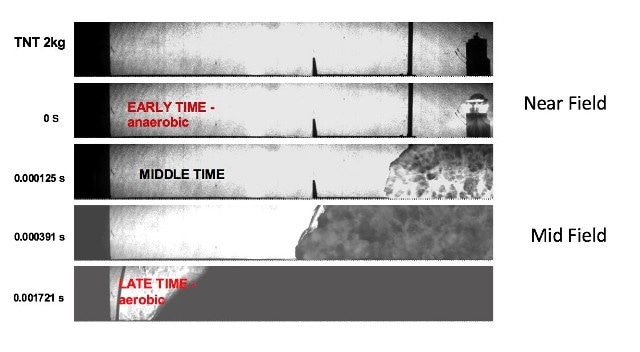Jun 1 2016
Director David Lean found it easy to wreck a train with great precision during the filming of "Lawrence of Arabia".
 Horizontal view 2m across of a 2 kg TNT cylinder being top-detonated. The detonation products expand into air at a rate of several mm/usec, with a shock at the surface of the products (the explosive near-field). As air drag slows the detonation products, the shock detaches and travels through the ambient air - the explosive mid-field. (McNesby/U.S. Army Research Laboratory)
Horizontal view 2m across of a 2 kg TNT cylinder being top-detonated. The detonation products expand into air at a rate of several mm/usec, with a shock at the surface of the products (the explosive near-field). As air drag slows the detonation products, the shock detaches and travels through the ambient air - the explosive mid-field. (McNesby/U.S. Army Research Laboratory)
Likewise, although it is possible to analyze explosives without them, the advent of new techniques comprising high-speed, high-fidelity imaging equipped with signal processing and optical filtering enables researchers to image explosions and capture data in real time, thus providing a practical option to create a new simulation.
Advances in high speed imaging, especially the recent availability of extremely fast cameras and light sources -- (those) approaching hundreds of kHz illumination and imaging rates at near megapixel image sizes -- have brought experimental imaging closer to the resolution achievable with simulations.
Kevin L. McNesby, Research Chemist at the U.S. Army Research Laboratory in Aberdeen, Maryland.
McNesby and his co-workers at the Army Research Laboratory, Lawrence Livermore National Laboratory, and Los Alamos National Laboratory have reported their findings in Review of Scientific Instruments, a journal from AIP Publishing.
The progress in image capturing enables the scientists to reduce the cost of acquiring data on explosive behavior by recording multiple variables, including temperature, pressure, and chemical species maps for each shot as opposed to a single point measurement. This enables the researchers to run one explosion not several.
The scientists’ technique of collecting information involves pyrometry, which determines temperature of incandescent bodies depending on their spectra of thermal radiation emitted. The experimental setup is specific to the kind of explosive being examined. It consists of a 2-color imaging pyrometer, which has two monochrome cameras that are filtered at 700nm and 900nm and a full-color single pyrometer that attains wavelength resolution with a Bayer-type mask encasing the sensor chip. The framing speeds for each one of their rigs are 20,000-40,000fps, at roughly 400 x 500 pixels resolution with an exposure per frame of one to tens of microseconds.
The pyrometers enable simultaneous measurement of pressure and temperature, thanks to their ability to record the detonation event’s air shock structure. Measuring the emission spectrum of all the targeted molecules helps gaining knowledge about the chemical species. Their setup enables them to have a spatial resolution for a 1kg explosive charge down to the 1mm scale.
However, the researchers’ mapping techniques involve error bars wider than those of ‘legacy’ point measurement methods, a drawback the scientists are trying to address. Going forward, the scientists will install a full upgrade of the imaging rig, enabling it to achieve a 10-fold improvement in terms of speed at full resolution.
K.L. McNesby, B.E. Homan, R.A. Benjamin, V.M. Boyle Sr., J.M. Densmore and M.M. Biss are the authors of the paper titled, "Quantitative Imaging of Explosions with High-Speed Cameras.”